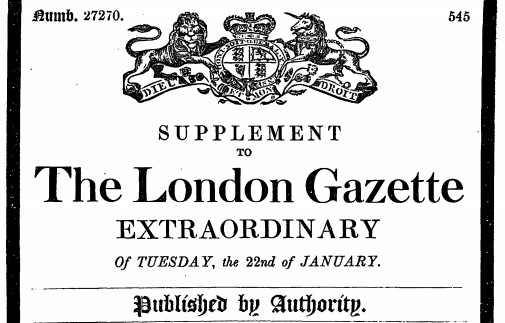When a bill is given royal assent, a company becomes incorporated, or a bankruptcy order is issued, there is one place in which all of these announcements are made: The Gazette.
The Gazette is the UK’s official public record and publishes notices, either because it is required by law, or to put official information permanently on the public record and in the public domain. Since 1665, The Gazette has recorded national and international events, and so it is the essential record for many researchers.
How the public and researchers access The Gazette, however, has changed dramatically over the last two decades. Before 1996, around 250,000 copies of the London, Edinburgh and Belfast Gazettes were printed daily; in 2018 just 80 copies are printed each day. So, what has changed in that time and how do people read and use The Gazette today?

Supplement to The London Gazette, 1901

The Gazette website, 2018
Since 1998, the information provided to The Gazette to form a new notice has been captured using Extensible Mark-up Language (XML), but it was not until 2013 that digital transformation really began to bring The Gazette to a 21st Century audience.
What does the process of submitting a notice look like in the 21st Century?
Today, notices to be published in The Gazette can be submitted either as full text or as data. If only the data is provided, then it is merged with an existing template to produce a full notice. Once the notice has been published, the RDFa (Route Description Framework in Attributes) is extracted from the notice and stored as RDF in a triple store. This provides both document views of the notice and data views of the notice. The linked data application programming interface (API) allows a notice to be retrieved via format-specific URLs. The formats that can be queried include PDF, TTL, RDF, JSON, HTML and XML.
Valid, authentic data
Being the official public record, all notice placers are verified to ensure that notices published by The Gazette are certified as fact. The Gazette now uses XML to add digital signatures to notices uploaded online. These digital signatures check that the information published is correct and unmodified, confirming the validity and authenticity of a digital document.
Longitudinal datasets
Datasets from The Gazette go back as far as 1900 and cover areas such as wills and probate, appointments and honours, and insolvencies. The ability to find these datasets and make use of them has since been greatly improved.
Any data submitted prior to 1997 has been extracted from historic Gazette documents, while the archive indexes have been processed from 1900 onwards, and notices from 1998 onwards. The Gazette is now a rich source of open data, including longitudinal datasets and linked data, and is available to search and use online for free.
Data for commercial use
The Gazette’s data is also invaluable to organisations such as credit reference agencies, banks and government departments, who use it to support risk and opportunity management.
Since The Gazette’s digital transformation, companies can choose to have data delivered in a number of different formats, including XLS, XML and CSV. Insolvency, deceased estates and companies notice data are offered as part of the service.
All of these changes to The Gazette mean that the publication retains its huge value and relevance in the digital age, to researchers, the public, businesses and professionals. Visit our website to find out more about the services we offer.